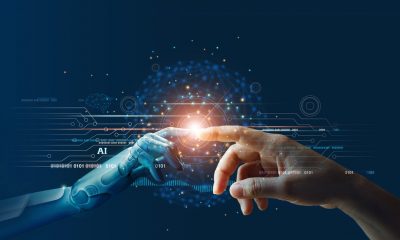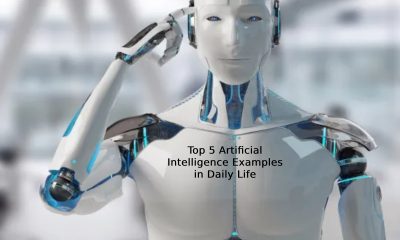Tech
Top 10 AI Trends That Will Transform Your Businesses
Published
10 months agoon
By
admin
Artificial Intelligence (AI) is no longer a futuristic concept; it has become an integral part of businesses across industries, transforming the way companies operate, innovate, and compete. AI technologies are evolving at a rapid pace, and organizations that adapt to these advancements stand to benefit immensely, driving efficiency, innovation, and customer satisfaction. The following article explores the top 10 AI trends that will significantly transform businesses in the coming years, providing insights into how these trends can be harnessed to create sustainable value.
1.AI-Powered Automation: Efficiency at Scale
Automation has been a key focus of AI development, and its impact on businesses is profound. AI-driven automation is not limited to simple, repetitive tasks; it’s now extending into more complex areas such as decision-making, customer service, and even creative tasks.
How AI-Powered Automation Transforms Businesses
- Operational Efficiency: AI automates mundane tasks like data entry, payroll, and scheduling, freeing employees to focus on more strategic functions.
- Improved Accuracy: Machine learning algorithms can reduce human error, especially in fields like finance and logistics.
- Cost Reduction: AI enables businesses to scale operations without needing a proportional increase in manpower, significantly reducing operational costs.
- Customer Service Transformation: AI-powered chatbots and virtual assistants provide 24/7 support, resolving customer queries in real time with increased accuracy and personalization.
Key Industries Benefiting
- Manufacturing is embracing AI-driven robotics to automate production lines.
- Retailers are using AI to automate inventory management and customer interaction.
- Financial institutions deploy AI algorithms to automate trading and fraud detection.
Automation powered by AI is poised to transform virtually every industry by driving greater efficiency, lowering costs, and enhancing decision-making capabilities. Companies that fail to invest in this technology may find themselves at a competitive disadvantage.
2.AI in Personalization: The Age of Hyper-Personalized Customer Experiences
The shift towards a customer-centric business model has made personalization a cornerstone of successful companies. AI takes personalization to the next level by analyzing large amounts of data to deliver individualized recommendations, offers, and content.
How AI Enhances Personalization
- Data-Driven Insights: AI algorithms process vast datasets to predict customer preferences and behaviors. By analyzing historical data and real-time interactions, businesses can offer personalized recommendations.
- Customized Marketing Campaigns: With AI, marketers can create targeted campaigns tailored to specific audience segments or even individual customers, enhancing engagement and conversion rates.
- Adaptive User Experiences: AI can modify website content, product recommendations, and even pricing in real time to suit the preferences of each user, providing a more engaging and relevant experience.
Examples in Action
- Netflix and Spotify use AI to recommend content based on users’ viewing and listening habits.
- Amazon and e-commerce platforms utilize AI to suggest products customers are more likely to purchase based on their browsing and buying behavior.
- Healthcare companies leverage AI to deliver personalized treatment plans and wellness recommendations.
As customers expect more personalized experiences, AI-driven customization will become essential for businesses seeking to maintain a competitive edge. Personalization driven by AI can lead to higher customer satisfaction, loyalty, and retention rates.
3.AI and Cybersecurity: Strengthening Defenses Against Threats
As cyber threats become more sophisticated, AI is emerging as a powerful tool to protect businesses from data breaches, malware, and other security threats. AI-driven cybersecurity solutions can detect anomalies, predict attacks, and even respond to security incidents in real time.
Key AI Applications in Cybersecurity
- Anomaly Detection: AI systems can analyze network traffic and user behavior to detect unusual patterns that could indicate a potential security threat.
- Predictive Analytics: Machine learning models can predict vulnerabilities or threats by analyzing past data, allowing businesses to preemptively address security risks.
- Automated Incident Response: AI systems can react to potential security breaches faster than human response teams, minimizing damage and disruption.
- Fraud Detection: In sectors like finance and e-commerce, AI-powered algorithms are highly effective in identifying fraudulent transactions in real-time, enhancing trust and security for businesses.
AI-Driven Cybersecurity in Action
- AI is being used by banks to detect fraudulent transactions by recognizing unusual patterns in financial data.
- Companies like IBM are developing AI-driven security platforms to automatically respond to cyber-attacks.
- Retailers use AI to identify and prevent e-commerce fraud, protecting customer data and financial information.
AI’s ability to analyze large datasets in real-time and recognize patterns beyond human capabilities is revolutionizing cybersecurity. As cyber threats evolve, businesses will increasingly rely on AI to safeguard their data and operations.
4.AI in Healthcare: Revolutionizing Diagnostics and Patient Care
Healthcare is one of the sectors that is poised to be radically transformed by AI. From diagnosing diseases to personalizing treatment plans, AI’s potential in healthcare is enormous, improving both patient outcomes and the efficiency of healthcare systems.
AI’s Impact on Healthcare
- Enhanced Diagnostics: AI algorithms, especially those using deep learning, are increasingly outperforming humans in diagnosing conditions such as cancer, heart disease, and neurological disorders. AI analyzes medical images, lab results, and even genetic data to provide faster and more accurate diagnoses.
- Predictive Healthcare: Machine learning models can predict disease outbreaks, patient recovery times, and the likelihood of disease progression, allowing for more proactive and preventative care.
- Robotic Surgery: AI-powered robotic surgery systems provide precision that surpasses human capabilities, reducing recovery times and the risks associated with human error.
Examples of AI in Healthcare
- IBM Watson uses AI to assist oncologists in identifying the most effective cancer treatment protocols based on patients’ medical histories.
- Google DeepMind is applying AI to improve the accuracy of medical imaging, helping radiologists detect diseases like breast cancer at early stages.
- AI-powered virtual nurses like Babylon Health assist patients in self-diagnosis and provide healthcare advice, improving accessibility to medical care.
As AI becomes more integrated into healthcare systems, it will lead to more accurate diagnoses, personalized treatments, and a more efficient healthcare delivery system overall. AI-driven advancements in healthcare could potentially save lives and revolutionize how care is provided.
5.AI-Enhanced Data Analytics: Turning Data into Actionable Insights
Businesses today are generating enormous volumes of data, but extracting actionable insights from that data can be challenging. AI-enhanced data analytics allows companies to process and interpret large datasets at unprecedented speeds, providing insights that would otherwise go unnoticed.
The Role of AI in Data Analytics
- Real-Time Analysis: AI can process vast amounts of data in real time, offering businesses the ability to react quickly to changes in the market or customer behavior.
- Predictive Analytics: Machine learning models predict future trends by analyzing historical data, helping businesses make more informed decisions.
- Natural Language Processing (NLP): AI-powered NLP algorithms can analyze unstructured data, such as customer reviews, social media posts, and news articles, to identify trends and customer sentiments.
Key Examples of AI-Driven Data Analytics
- Financial institutions use AI for risk assessment, detecting trends in market data, and optimizing investment portfolios.
- Retailers use AI to analyze consumer behavior, predict shopping patterns, and optimize inventory levels.
- Marketing teams use AI to analyze social media sentiment, improving their campaigns by understanding consumer needs and preferences.
AI-enhanced data analytics allows businesses to convert raw data into actionable insights, enabling better decision-making, increasing operational efficiency, and driving business growth. Data-driven decision-making is fast becoming a critical component of success in the modern business landscape.
6.AI in Supply Chain Optimization: Streamlining Operations
The global supply chain is complex and interconnected, with many moving parts. AI offers solutions that streamline logistics, predict demand, and optimize inventory management. AI-driven supply chain optimization can improve efficiency, reduce costs, and ensure smoother operations.
AI’s Role in Supply Chain Management
- Demand Forecasting: AI models analyze historical sales data, market trends, and even weather patterns to predict future demand accurately, allowing companies to manage inventory more efficiently.
- Route Optimization: AI-powered logistics platforms help optimize delivery routes in real time, considering traffic, weather conditions, and delivery deadlines, ensuring timely and cost-effective transportation.
- Automated Warehousing: Robotics and AI-driven automation are transforming warehouse management by optimizing storage, streamlining inventory handling, and reducing human error.
Key Examples
- Amazon and Alibaba leverage AI to predict consumer demand, manage inventory, and streamline delivery operations, improving their supply chain efficiency.
- Walmart uses AI for demand forecasting and inventory optimization, reducing waste and ensuring products are always in stock.
- AI-powered robots are increasingly used in warehouses for picking and packing products, speeding up order fulfillment while reducing errors.
The ability of AI to process large amounts of data and offer predictive insights is revolutionizing supply chain management. Businesses that adopt AI for supply chain optimization will see significant improvements in operational efficiency and cost savings.
7.AI in Human Resources: Smarter Recruitment and Employee Management
The integration of AI into human resources (HR) is streamlining processes such as recruitment, employee engagement, and performance management. AI tools are not just improving efficiency but also helping HR professionals make better, data-driven decisions.
AI’s Role in HR
- AI-Powered Recruitment: AI can screen resumes, match candidates to job profiles, and even conduct initial interviews using natural language processing (NLP). This reduces the time HR teams spend on repetitive tasks and increases the likelihood of finding the right candidate.
- Employee Engagement: AI-driven platforms can monitor employee sentiment by analyzing feedback, emails, and social interactions, enabling HR teams to proactively address workplace issues and improve morale.
- Performance Management: AI can analyze employee performance data to identify trends, potential challenges, and areas for development, offering personalized training and development recommendations.
Examples of AI in HR
- HireVue uses AI to analyze video interviews, assessing candidates’ language, tone, and non-verbal cues to make recommendations on fit and performance potential.
- LinkedIn Recruiter utilizes AI to suggest potential candidates based on a company’s hiring history and a candidate’s online profile.
- AI-driven employee engagement platforms like Glint analyze feedback and suggest actions to improve team morale and performance.
AI is transforming the HR landscape by making recruitment more efficient, improving employee satisfaction, and driving better performance management. By leveraging AI, businesses can create more productive, engaged, and satisfied workforces.
8.Natural Language Processing (NLP): Bridging the Communication Gap
Natural Language Processing (NLP), a subset of AI, focuses on enabling machines to understand and process human language. NLP is transforming how businesses interact with customers and manage information, from chatbots to sentiment analysis and content generation.
How NLP is Transforming Business
- Customer Support Automation: AI chatbots powered by NLP can handle routine customer inquiries, freeing up human agents to focus on more complex tasks.
- Sentiment Analysis: NLP algorithms can analyze customer reviews, social media posts, and other unstructured data to gauge customer sentiment and identify areas for improvement.
- Content Generation: AI-driven platforms use NLP to create content automatically, from marketing copy to news articles, saving time and resources.
Key Examples of NLP
- Chatbots like those used by companies such as Zendesk and Drift can respond to customer queries in real-time, improving customer satisfaction.
- Social media platforms use NLP to filter out inappropriate content and analyze sentiment around trending topics.
- AI content generation platforms like OpenAI’s GPT are helping businesses create high-quality content at scale.
NLP is revolutionizing how businesses interact with their customers and process vast amounts of text data. As NLP technology continues to improve, businesses will benefit from more efficient communication and better insights into customer needs and preferences.
9.AI and Edge Computing: Bringing AI Closer to the Source
Edge computing is the practice of processing data closer to where it is generated, rather than relying solely on cloud-based systems. This trend, when combined with AI, can offer real-time data processing and decision-making at the source, improving performance and reducing latency.
AI’s Role in Edge Computing
- Real-Time Analytics: AI-powered edge computing enables real-time data processing, making it ideal for industries where immediate insights are crucial, such as manufacturing, autonomous vehicles, and smart cities.
- Reduced Latency: By processing data locally, AI at the edge minimizes the delays caused by transmitting data to central servers, ensuring faster response times for critical applications.
- Increased Security: With sensitive data being processed locally, edge computing combined with AI can reduce the risk of data breaches that could occur when transmitting data to cloud-based systems.
Industries Benefiting from AI at the Edge
- Autonomous vehicles rely on AI and edge computing to make split-second decisions based on data from sensors and cameras.
- Smart manufacturing systems use AI at the edge to monitor equipment in real time and predict maintenance needs before a breakdown occurs.
- Retailers use AI at the edge for real-time inventory management and customer behavior tracking, improving store efficiency and customer experience.
As the need for real-time decision-making grows, the combination of AI and edge computing will become critical in industries where speed and security are paramount. By processing data at the source, businesses can achieve faster results and make more informed decisions.
10.AI in Sustainability: Driving Environmental and Business Goals
Sustainability is becoming a key priority for businesses, driven by consumer demand, regulatory requirements, and a growing awareness of environmental issues. AI can play a significant role in helping businesses meet their sustainability goals, reducing waste, optimizing resource use, and even developing new environmentally friendly products.
AI’s Role in Driving Sustainability
- Energy Efficiency: AI can optimize energy use in buildings, manufacturing processes, and data centers, reducing overall energy consumption and carbon footprints.
- Waste Reduction: AI-powered supply chain optimization helps businesses reduce waste by improving inventory management, reducing overproduction, and minimizing unsold goods.
- Sustainable Product Design: AI-driven innovation platforms assist businesses in designing products with a lower environmental impact, from sourcing sustainable materials to optimizing product lifecycles.
Examples of AI in Sustainability
- Google uses AI to reduce energy usage in its data centers, leading to significant reductions in its overall carbon footprint.
- Siemens uses AI in its smart grid technology to optimize energy distribution, reducing waste and improving efficiency.
- Unilever employs AI to monitor its supply chain, ensuring sustainable sourcing and reducing its environmental impact.
As businesses increasingly prioritize sustainability, AI will play a critical role in helping them meet environmental goals while also driving efficiency and cost savings. AI-driven sustainability initiatives not only benefit the environment but also enhance brand reputation and customer loyalty.
Conclusion
AI is reshaping businesses across all sectors, offering new ways to drive efficiency, enhance customer experiences, and achieve long-term growth. From automation and personalization to cybersecurity and sustainability, the potential applications of AI are vast and varied. The key to success for businesses lies in embracing these AI trends early, understanding their implications, and investing in the right technologies to remain competitive in an ever-evolving marketplace. By leveraging AI effectively, businesses can unlock unprecedented opportunities for innovation, transformation, and value creation.

Microsoft’s Windows is the cornerstone of personal computing – a platform billions rely on daily. In October 2021, Windows 11 debuted as the boldest Windows upgrade in years, boasting a modern interface, tighter hardware requirements, and features that reimagine productivity, gaming, and security.
This comprehensive guide—reflecting insights in “https://seguridadinformaticahoy.com/todo-sobre-windows-11”—dives into every facet of Windows 11: from its core design and feature set to performance improvements, tips, and potential caveats. Whether you’re a home user, gamer, or enterprise IT pro, you’ll gain a deep understanding of what Windows 11 truly delivers.
What’s New in Windows 11
Windows 11 is more than a minor facelift—it’s built on fresh aesthetics, AI elements, and next-gen hardware integration. Here’s what stands out:
-
Centered Start Menu & Taskbar: A macOS-inspired design with revamped icons and a centered layout that balances minimalism and efficiency.
-
Widgets: Reimagined widgets panel offering news, calendar, weather, and productivity insights at a glance.
-
Snap Layouts & Groups: Effortless window arrangement and group recall—great for multitasking and workflows.
-
Microsoft Teams Integration: A built-in Teams Chat accessible via the Taskbar.
-
Android App Support: Users can install Android apps via the Amazon Appstore (currently via beta).
-
Gaming Features: Auto HDR, DirectStorage, and optimized graphics performance.
-
Improved Windowing: Focused on sleek transitions, rounded corners, and taskbar enhancements.
All these updates are fully explained in “https://seguridadinformaticahoy.com/todo-sobre-windows-11,” which highlights Microsoft’s goal: reinvent usability while aligning with modern hardware trends.
System Requirements & Installation Guide
Minimum Requirements
To run Windows 11, your system must meet:
-
CPU: 1 GHz or faster, 2+ cores, 64-bit, on approved list
-
RAM: 4 GB
-
Storage: 64 GB
-
Firmware: UEFI, Secure Boot capability
-
TPM: Trusted Platform Module (TPM 2.0)
-
Display: 9” or larger, HD (720p), 8 bits/channel
-
Graphics: DirectX 12 / WDDM 2.x compatible
-
Internet: Microsoft Account + internet required for Home editions
TPM 2.0 proves essential and has sparked controversy with legacy machines being left out. But it’s a cornerstone for upgraded security.
How to Check Compatibility
-
PC Health Check App: Official tool from Microsoft.
-
Third-Party Tools: Utilities like WhyNotWin11 offer breakdowns.
-
BIOS Settings: Enable TPM, Secure Boot, virtualization.
Upgrade vs. Clean Install
-
In-Place Upgrade: Keeps your files/settings; easiest route for current Windows 10 users.
-
Clean Install: Fresh start; ideal for reclaimed SSDs or wiping malware. Use the official Media Creation Tool or ISO.
Step-by-Step Clean Install
-
Backup files with OneDrive, external drive, or clone tools.
-
Download Media Creation Tool from Microsoft.
-
Create Bootable USB (8 GB min).
-
Enable Secure Boot & TPM 2.0 in UEFI.
-
Boot from USB and install.
-
Sign in with Microsoft Account.
-
Personalize & activate updates/apps.
Don’t skip updates—they often fix teething issues for new adopters.
Redesigned Interface and User Experience
Aesthetic Refresh
Windows 11 introduces:
-
Centered Start & Taskbar with floating windows and rounded corners.
-
New system icons for modern consistency.
-
Transparent Acrylic taskbar, enhancing design depth.
-
Light/Dark Themes: Sync across elements and support dynamic desktop changes.
Start Menu & Search
-
Simplified layout: Pinned apps show front-and-center; recent files dynamically appear.
-
Universal Search integrates local files, apps, and web results.
Snap Layouts, Groups & Desktops
Hover over maximize to access Snap Layouts:
-
Choose layout templates or create your own multi-window setups.
-
Snap Groups let you toggle full multi-app workflows.
-
Virtual Desktops are now customizable with distinct wallpapers.
Widgets Panel
-
Find widgets with Taskbar toggle; personalize news, tasks, weather, and stock info.
-
Built-in Widgets API allows third-party extension over time.
Taskbar & Quick Settings
-
Unified pull-downs for Wi-Fi, volume, battery, and alerts.
-
Notifications appear grouped with an option to clear all in one go.
Productivity Features & Workflows
Microsoft Teams Chat
Integrated in Taskbar:
-
One-click start for personal chat, calls, or screen sharing.
-
Individual chat flow, not the full Teams interface—useful for quick communication.
Focus Sessions & Clock/Pomodoro
-
Set timers, link Spotify, and enable Do Not Disturb.
-
Motivation built in—great for structured work bursts.
Content-Aware Snipping & Screen Recording
-
Snipping Tool and Snag It alternatives are now native.
-
Clips from the xbox Game Bar support both gaming and productivity scenarios.
Voice Typing & Windows Dictation
-
Powered by cloud AI: improved accuracy and punctuation.
-
Rich voice commands for tasks like “delete that sentence.”
Context Menus & File Explorer
-
Simplified right-click options; advanced options hidden under “Show more.”
-
New command bar for File Explorer provides clarity and easier navigation.
Gaming on Windows 11
Microsoft’s PC gaming leap with Windows 11 is substantial:
Auto HDR
Adds high-dynamic-range color to DirectX 11+ games automatically, even non-HDR titles.
DirectStorage
Drastically increases data throughput, leading to faster load times on NVMe drives.
Xbox App & Game Pass
Now native to Taskbar, connecting you to online gaming, social, and streaming.
Unified Game Bar
Overlay for real-time FPS, recording, chat, and performance overlays.
Gamers benefit from more responsive gameplay and immersive visuals.
Security Enhancements
Security underpins Windows 11’s design:
TPM 2.0 & Secure Boot
Foundation for hardware-based encryption, key protection, and system integrity.
Windows Hello & Modern Authentication
Password-free login: facial recognition, fingerprint, and PIN sign-in.
Enhanced Hardware-Assisted Security
VBS (Virtualization-Based Security) and HVCI (Hypervisor-Enforced Code Integrity) are now enabled by default on capable hardware.
Smart App Control
AI-driven tool allowed only signed and trusted apps—blocks malware, office threats. Initially in preview, expanding via updates.
Microsoft Defender Updates
Security core UI redesigned, faster scans, enhanced phishing and ransomware guardrails.
App Ecosystem & Microsoft Store
Store Revamp
Revitalized UI boosts discoverability, faster load, and rich previews.
Broadened App Support
Win32, UWP, PWAs, and unpackaged store apps all available—more inclusive than before.
Android App Preview
Currently in beta via Amazon Appstore and Windows Subsystem for Android:
-
Install popular apps like TikTok, Kindle, and Zoom.
-
Performance still maturing, but early feedback is promising.
Progressive Web Apps (PWAs)
Installable via Edge with offline capabilities—great for frequent web tools.
Tips, Tricks, and Customization
Maximize your Windows 11 experience:
1. Rename Snap Layouts
-
Use
Win + Z, drag windows. -
Customize by dragging and positioning.
2. Create Virtual Desktop Workflows
-
Rename desktops (Work, School, Play).
-
Assign apps to desktops via right-click in Task Manager.
3. Use Focus Sessions
-
Access via Clock app—great for concentration.
-
Adds structure and syncing with Outlook.
4. Enable Smart App Control
-
Found in Settings → Privacy & Security.
5. Turbocharge Performance
-
Use Game Mode, Graphics Performance Preferences, and power plans.
-
Use Task Manager’s “Startup” tab to trim bloatware.
6. Customize the Taskbar
-
Drag items, sliver icons off, and anchor Widgets or Chat.
7. Use New File Explorer Shortcuts
-
Win + Efor Explorer, context switch via shortcut or command bar.
8. Animate with Voice Access
-
Controls like “Open Edge, Scroll down 3 pages, Click link” are fully supported.
9. Harness Whatsapp Web via PWA
-
Install from Edge—gives near-native desktop usability.
10. Tweak Touch & Pen Settings
-
Pen gestures, handwriting recognition, gestures via Settings → Bluetooth & devices.
Common Issues and Troubleshooting
Boot or Blue Screen on Unsupported Hardware
-
TPM 2.0 or Secure Boot issues: check BIOS, or choose Clean Install via ISO.
-
For older CPUs: bypass flag in registry during install—but not recommended for mainstream use.
Battery Drain & Performance Issues
-
AV scans, telemetry, and indexing increase workload.
-
Switch to Balanced or Power saver, disable telemetry via Group Policy.
Broken Audio or Display Drivers
-
Use Intel’s DCH drivers, latest AMD/NVIDIA Game Ready or Studio drivers.
Android App Not Working?
-
Ensure Windows Subsystem for Android is installed and in preview, and enable virtualization.
Taskbar or Widgets Broken
-
Run
sfc /scannow, reinstall stock apps via PowerShell (“Get-AppxPackage…”).
Snap Layout Stuck?
-
Re-enable Snap Assist in Settings → System → Multitasking.
FAQs
Is Windows 11 a free upgrade?
Yes—if you’re on licensed Windows 10 with hardware support, Microsoft offers a free upgrade via Windows Update.
Can I revert to Windows 10?
Yes, within 10 days of upgrade. Settings → System → Recovery → Roll back.
Why do I need TPM 2.0?
It secures keys and system integrity; foundational for modern ransomware resistance.
Are all Windows 10 apps compatible?
Over 99% install and run fine. Only a few low-level tool conflicts—mostly edge cases.
Do I need a Microsoft account?
Home edition requires it. Enterprise/LTSC allows local accounts.
Personalization tied to account access.
Conclusion
Windows 11 stands out not just in design, but in performance, security, and flexibility. Whether for daily tasks, creative workflows, or immersive gaming, its refreshed UI, productivity enhancements, and robust security make it compelling.
From rounded corners and centered Taskbar to Auto HDR and Smart App Control, it brings modern polish across the board. TPM 2.0 and VBS keep your system protected against modern threats. Android app support and progressive web apps broaden your software horizons.
Tech
Top 3 Advanced Persistent Threats and How Businesses Can Stop their Attacks
Published
3 months agoon
April 24, 2025By
admin
Businesses of various sizes and fields are susceptible to advanced persistent threats (APTs). According to the cybersecurity company ANY.RUN, in the first quarter of 2025 the most active phishing groups were Storm1747, TA569, and Storm1575. isn’t limited to, finance, media, and cybersecurity.
To protect the infrastructure of your organization, learn about their tactics and weak spots below.
Storm1747 – detected 16,140 times in January–March 2025
Storm1747 is a cybercriminal group responsible for the Tycoon 2FA phishing kit. It’s known to evade detection systems by using malicious QR codes. Still, such attacks don’t go unnoticed. The adversaries leave traces, and they can be identified.
To retrieve information on them and protect your company, use threat intelligence services. Here’s how to investigate threats in ANY.RUN’s TI Lookup, a constantly updated searchable database of IOCs, IOAs, and IOBs of the most recent attacks:
1.Enter the query
TI Lookup allows you to conduct compound searches. For example, let’s browse its database to look for threats flagged as Storm1747 and involving QR codes by entering this query:
threatName:”storm1747″ AND threatName:”qrcode”

In TI Lookup, you can form compound searches with any of over 40 available parameters
Explore current cyber threats with 50 trial requests in TI Lookup
2.See the results
Now we can see a list of all freshly gathered threat samples that fit our requirements:

The list of threat samples that fit our query
3.Collect actionable intel to enrich your defense
Each contains an in-depth threat context. By clicking any of the search results, you can continue the analysis in ANY.RUN’s Interactive Sandbox for malware analysis to collect detailed info on each threat and interact with malicious files safely to understand their behavior:

Interact with malware for further analysis in ANY.RUN’s Sandbox
That’s how you can analyze recent attacks, collect their indicators, and take measures to protect your company from upcoming threats associated with them.
TA569 – detected 1,005 times in January–March 2025
TA569 is a threat actor responsible for the SocGholish malware injected into compromised websites via malicious JavaScript.
With this simple search query in TI Lookup, we can find our which domains fell victim to SocGholish:
threatName:”socgholish” AND domainName:””

Search results for domains associated with the SocGholish
You can also subscribe to this or any other query via the Search Updates feature to keep track of the threats as they evolve. In this case, information on fresh attacks will appear on your dashboard highlighted in green.

Search Updates in TI Lookup allow you to track evolving threats
Storm1575 – detected 762 times in January–March 2025
TI Lookup allows you to check if an indicator has anything to do with a threat. For instance, you would like to find out whether a website is related to malicious activities. All you have to do is to browse the database for its mentions using a query like that:
domainName:”castirontexas[.]com”
And in a moment’s time, you’ll know that this website is associated with Storm1575, one of the leading recent cyber criminal groups. It’s known to conduct attacks targeting companies globally via the Dadsec platform.

The website we checked is associated with malicious activities
Try TI Lookup to Enrich Alerts and Speed up Incident Response
TI Lookup’s searchable database provides you with the most up-to-date information on the latest cyber threats and enables business and organizations to:
- Detect and identify attacks before they cause damage
- Investigate and browse IOCs, IOAs, and IOBs for more insights on threat actors
- Enhance the efficiency of your security team’s workflow
- Gain access to data that helps take proactive action against cyber threats
Over 500,000 security professionals worldwide, including SOC teams from 15,000 companies, contribute to ANY.RUN’s database, keeping it relevant and abundant.
Tech
How Accurate Pulley Alignment Can Prevent Equipment Failures
Published
3 months agoon
April 22, 2025By
admin
In industrial settings, the smooth operation of machinery is essential for productivity and safety. One often overlooked aspect that can significantly impact machinery performance is pulley alignment. Proper alignment of pulleys ensures that belts run smoothly, reducing wear and tear on equipment components and minimizing the risk of costly breakdowns. In this article, we’ll explore the importance of accurate pulley alignment and how it can prevent equipment failures.
Understanding Pulley Alignment
Pulleys are critical components in various types of machinery, including conveyor systems, pumps, and motors. They transmit power from one rotating shaft to another via belts or chains. When pulleys are misaligned, even slightly, it can lead to a range of problems, including increased friction, excessive vibration, and premature wear on belts and bearings.
Common Causes of Misalignment
Several factors can contribute to pulley misalignment, including:
- Installation Errors: Improper installation of pulleys or shafts can result in misalignment from the start.
- Belt Tension: Inadequate or uneven belt tension can cause pulleys to shift out of alignment over time.
- Shaft Deflection: Shaft deflection due to excessive loads or improper support can lead to misalignment issues.
- Thermal Expansion: Temperature fluctuations within the machinery can cause components to expand or contract, affecting pulley alignment.
Impact of Misalignment on Equipment
Misaligned pulleys can have significant consequences for machinery and production processes, including:
- Increased Wear and Tear: Misalignment causes excessive friction, leading to accelerated wear on belts, bearings, and other components.
- Reduced Efficiency: Machinery operates less efficiently when pulleys are misaligned, resulting in higher energy consumption and reduced productivity.
- Vibration and Noise: Misalignment often results in excessive vibration and noise, which can be disruptive and potentially harmful to equipment and personnel.
Preventive Measures
Preventing pulley misalignment is key to maintaining equipment reliability and prolonging service life. Here are some preventive measures to consider:
- Regular Inspection: Conduct routine inspections of pulley alignment using precision tools such as a laser alignment tool. Identify and correct misalignment issues promptly.
- Proper Installation: Ensure that pulleys and shafts are installed correctly according to manufacturer guidelines to minimize the risk of misalignment from the outset.
- Belt Tensioning: Maintain proper belt tension to prevent slippage and minimize the likelihood of pulley misalignment.
- Temperature Monitoring: Monitor temperature fluctuations within the machinery and take measures to minimize thermal expansion effects on pulley alignment.
Importance of Laser Alignment Tools
Laser alignment tools are invaluable for achieving precise pulley alignment. These advanced devices use laser technology to measure and adjust the position of pulleys with unparalleled accuracy. By providing real-time feedback and visual guidance, laser alignment tools enable operators to achieve optimal alignment quickly and efficiently.
Conclusion
In conclusion, accurate pulley alignment is crucial for preventing equipment failures and ensuring the smooth operation of industrial machinery. By addressing misalignment issues proactively and utilizing advanced tools such as laser alignment tools, manufacturers can minimize downtime, reduce maintenance costs, and enhance overall productivity. Investing in proper pulley alignment practices is a wise decision that pays dividends in the form of improved equipment reliability and performance.
Remember, maintaining optimal pulley alignment is not just a matter of efficiency—it’s a fundamental aspect of ensuring the safety and longevity of industrial equipment.

The Ultimate Guide to the Best Android Strategy Games in 2025: What to Play and Why

What Are the Most Effective Digital Marketing Strategies?

Everything You Need to Know About Windows 11

The Best E commerce Platforms for Small Businesses in 2025

How to Start Coding from Zero Level with No Prior Experience

Why Great Output Doesn’t Always Mean Great Performance

Top 3 Advanced Persistent Threats and How Businesses Can Stop their Attacks

14 Actionable Tips to Improve Your Manufacturing Business

10 Tips for Optimizing Images for SEO

10 Most Profitable Businesses in India
Trending
-

 Miscellaneous3 years ago
Miscellaneous3 years agoSubnautica Below Zero Map – Know About Complete World Map and Coordinates 2021
-

 Mobile2 years ago
Mobile2 years agoVivo Company Belongs to Which Country? Vivo Made in Which Country? Is Vivo Chinese Company?
-

 Gaming2 years ago
Gaming2 years agoWhen Did the PS4 Come Out
-

 Gaming3 years ago
Gaming3 years agoWhy F95 Zone is the Leading Gaming Community?







